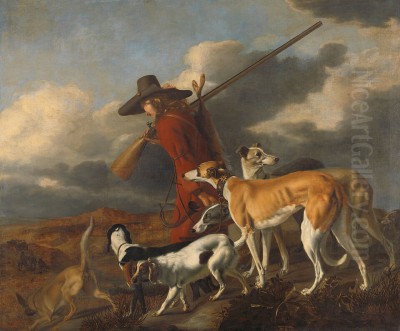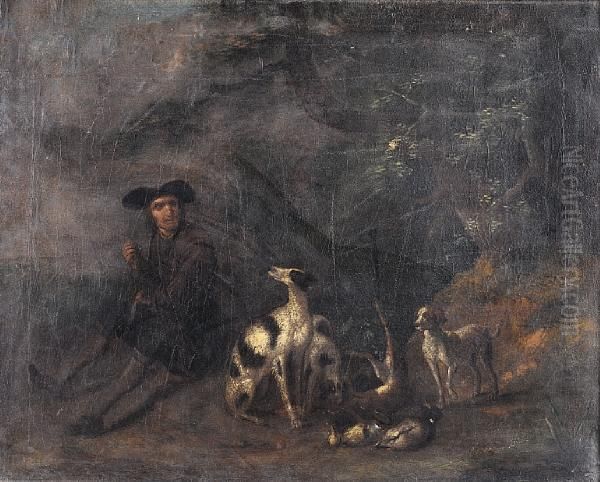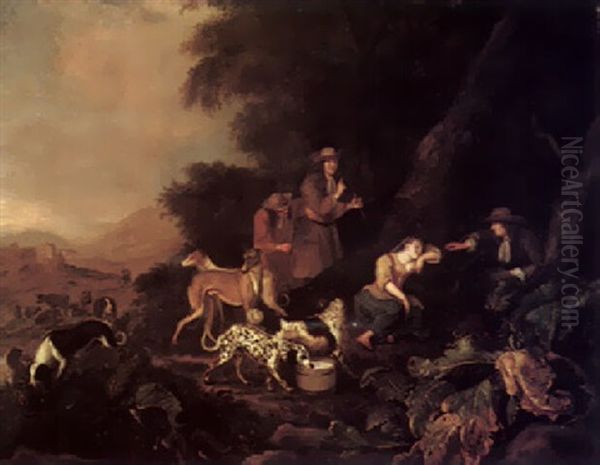
Adriaen Cornelisz Beeldemaker stands as a notable figure within the rich tapestry of the Dutch Golden Age of painting. Active during a period of extraordinary artistic output in the Netherlands, Beeldemaker carved a specific niche for himself, becoming particularly renowned for his lively depictions of hunting scenes. Born in 1618 and living a long life until 1709, his career spanned a significant portion of this vibrant century. While perhaps not possessing the widespread modern fame of contemporaries like Rembrandt or Vermeer, Beeldemaker was a successful and respected artist in his time, known for producing works that were both engaging and accessible to a broad audience. His life and work took him through several key Dutch cities, reflecting the interconnected nature of the art world during this era.
Origins and Early Career
Adriaen Cornelisz Beeldemaker's story begins in Rotterdam, where he is understood to have been born in 1618. The details of his earliest training remain somewhat unclear, a common situation for many artists of the period. However, some art historians suggest that his early works, characterized by fine attention to detail and a smooth surface finish, may indicate the influence of a teacher like Pieter Isaacsz, an artist known for historical paintings and portraits who was active in Amsterdam but had connections across the region. Beeldemaker's formative years occurred during a time when the Dutch Republic was flourishing economically and culturally, creating fertile ground for artists to thrive.

By the mid-17th century, Beeldemaker was establishing himself as a professional painter. Archival records provide glimpses into his life and movements. We know he was residing in Rotterdam in 1649, the year he married. At that time, his address was noted as being on the Vissersdijk, a location interestingly associated with the family of another prominent Dutch Golden Age painter, Pieter de Hooch. While this doesn't confirm a direct working relationship at this early stage, it places Beeldemaker within the physical proximity of other active artists in the bustling port city. Following his time in Rotterdam, he is known to have moved to Delft, a city famed for its own artistic milieu, most notably associated with Johannes Vermeer. It was likely in Delft and subsequent locations that Beeldemaker further developed his artistic practice and reputation.
It is worth noting a potential point of confusion regarding his name. Some sources mention an "Adriaen Cornelisz Beddelmaker" with similar dates (c. 1620-1709). However, based on the preponderance of evidence and scholarly consensus, this is generally considered a likely misspelling or confusion. The established identity and biographical details firmly point to Adriaen Cornelisz Beeldemaker, born in 1618 and deceased in 1709, as the artist known for hunting scenes. This confirmation of his lifespan from 1618 to 1709 provides a solid framework for understanding his long and productive career.
The Painter of the Chase
The defining characteristic of Adriaen Cornelisz Beeldemaker's artistic output is his specialization in hunting scenes. He became particularly well-known for his depictions involving deer and wild boar. These subjects were popular themes in Dutch art, reflecting the interests of a society that valued the countryside, leisure pursuits, and perhaps the status associated with the hunt, even if primarily enjoyed by the aristocracy. Beeldemaker's approach captured the energy and drama of the chase, often featuring packs of hounds in dynamic pursuit of their quarry within landscape settings.
A key factor contributing to Beeldemaker's success was the accessibility of his work. Sources indicate that his paintings were generally offered at moderate prices. This strategy likely broadened his market considerably, allowing a wider segment of the Dutch populace, beyond the wealthiest patrons, to acquire his art. This popularity speaks to his ability to connect with contemporary tastes and produce appealing, well-executed paintings that found ready buyers. His prolific nature further cemented his reputation as a reliable source for this type of popular imagery.

Specific works help anchor his career timeline and thematic focus. A painting titled `The Hunter`, dated 1653, confirms his active engagement with his signature subject matter by the mid-century. While hunting scenes formed the core of his oeuvre, he also explored related themes. The mention of a work titled `Dogs in a landscape` suggests that he also painted compositions focusing more broadly on animals within natural settings, perhaps moving beyond the explicit narrative of the hunt itself. This indicates a degree of versatility within his chosen specialization, likely appealing to patrons interested in animal painting and landscape elements.
Stylistically, Beeldemaker's work fits within the broader trends of Dutch realism. His early paintings, possibly reflecting his initial training, are noted for their careful rendering of details and smooth finish. Over time, like many artists, his style may have evolved. There is mention of him incorporating stylistic elements from other artists, such as Cornelis van der Haar, suggesting an awareness of and dialogue with the work of his contemporaries. His skill lay in combining convincing depictions of animals in motion with atmospheric landscape backgrounds, creating engaging and often dramatic visual narratives.
A Career Across Holland: Rotterdam, Leiden, and Dordrecht
Beeldemaker's professional life was not confined to a single location. His movements between major Dutch cities illustrate the mobility of artists during the Golden Age, seeking opportunities and establishing connections in different centers. His initial base in Rotterdam, marked by his 1649 marriage and residence on the Vissersdijk near the De Hooch family, placed him in one of the Republic's most dynamic commercial hubs. While Delft followed, Leiden also features significantly in his biography.
Leiden, a prominent university city and Rembrandt van Rijn's birthplace, was another center of artistic activity, known particularly for the 'fijnschilders' (fine painters) like Gerard Dou. Beeldemaker's connection to Leiden is solidified by records indicating he rented a house there, specifically Rapenburg 42, from none other than Pieter de Hooch. This transaction provides a concrete link between the two artists, suggesting a level of professional or personal acquaintance. Furthermore, Beeldemaker married his second wife, Sara Tegelbergh, in Leiden in 1665, reinforcing his ties to the city during this period.
Dordrecht, another important city with a distinct artistic tradition (home to artists like Aelbert Cuyp), appears to have been a place of significant success for Beeldemaker. Evidence suggests he worked there and achieved recognition, even winning a competition. His association with local Dordrecht artists, such as Cornelis Bisschop and possibly Bart Breen , indicates his integration into the local art scene. This success in Dordrecht underscores his ability to adapt and find patronage in various regional centers, each with its own network of artists and collectors.
Influence and Artistic Lineage
Beyond his own prolific output, Adriaen Cornelisz Beeldemaker played a role in the continuation of artistic traditions through teaching. Sources mention that he had numerous students, a common practice for established masters in the Dutch Golden Age. Guild systems often required artists to train apprentices, ensuring the transmission of skills and styles across generations. Beeldemaker's studio would have been a place where aspiring artists learned the techniques of painting, particularly focusing on his specialized subject matter.
His most direct artistic legacy lies within his own family. Two of his sons, Cornelis Beeldemaker (sometimes referred to as Cornelis Beeldemaker I) and Frans Beeldemaker, followed in his footsteps and became painters themselves. They likely received their primary training from their father, absorbing his style and thematic interests. While perhaps not achieving the same level of recognition as Adriaen, their careers demonstrate the continuation of the Beeldemaker name within the Dutch art world. The family's artistic presence extended further, with later generations, including individuals named Cornelis and Cecilia Beeldemaker, noted as being active in the artistic community of Dordrecht. This familial continuity highlights the craft-based nature of art production in the era and Beeldemaker's role in establishing a multi-generational artistic practice.
Beeldemaker in the Context of the Dutch Golden Age
To fully appreciate Adriaen Cornelisz Beeldemaker's position, it is essential to view him within the broader context of the Dutch Golden Age. This era saw an unprecedented flourishing of the arts, driven by economic prosperity, national pride, and a burgeoning middle-class market for paintings. Unlike in Catholic countries where the church was a primary patron, Dutch art was largely commissioned by secular individuals, leading to a demand for subjects reflecting everyday life, landscapes, portraits, still lifes, and genre scenes.
Specialization became a hallmark of the period. While versatile masters like Rembrandt explored various genres, many artists focused on specific niches. Beeldemaker's concentration on hunting scenes places him alongside other specialists, such as Paulus Potter, who was renowned for his depictions of livestock in pastoral settings, or Willem van de Velde the Younger, who mastered marine painting. Beeldemaker catered to a specific taste for dynamic animal scenes, distinct from the intimate interiors of Vermeer or Jan Steen, the detailed still lifes of Willem Kalf or Adriaen Coorte, or the evocative landscapes of Jacob van Ruisdael and Meindert Hobbema.
His connections, both documented (like renting from Pieter de Hooch) and geographical (working in cities alongside figures like Cornelis Bisschop), illustrate the interconnectedness of the Dutch art world. Artists often belonged to the same Guild of Saint Luke in their respective cities, influencing and competing with one another. While Beeldemaker's style might be seen as more straightforwardly narrative than the psychologically complex portraits of Frans Hals or the profound biblical interpretations of Rembrandt, his work fulfilled a significant market demand. The rise of genre painting, elevated by artists like Gerard ter Borch, Gabriel Metsu, and Gerard Dou, created an environment where Beeldemaker's accessible and lively scenes found a receptive audience.
Conclusion: A Respected Master of His Niche
Adriaen Cornelisz Beeldemaker navigated the competitive art world of the Dutch Golden Age with considerable success. His long life (1618-1709) allowed him to witness and participate in much of this remarkable artistic period. By specializing in hunting scenes featuring deer and boar, he tapped into a popular market, making his work desirable through both its subject matter and its relative affordability. His activity across major centers like Rotterdam, Delft, Leiden, and particularly Dordrecht, demonstrates his ability to establish himself and find patronage in various locations.
While not aiming for the lofty historical or allegorical subjects of some contemporaries, Beeldemaker excelled within his chosen genre. His paintings offered dynamic compositions, skilled animal depiction, and engaging narratives of the chase. Furthermore, his role as a teacher and the continuation of his artistic practice through his sons, Cornelis and Frans Beeldemaker, underscore his contribution to the artistic fabric of the time. Though perhaps overshadowed in modern art history surveys by the giants of the era, Adriaen Cornelisz Beeldemaker remains a significant figure, a master craftsman who skillfully chronicled a specific aspect of Dutch life and leisure, leaving behind a substantial body of work that reflects the tastes and interests of his time.